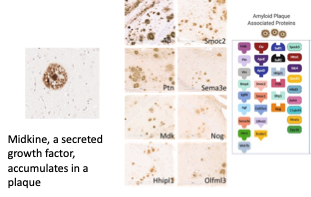Research Area #1: Leveraging an enhanced multi-omic, systems level understanding of Alzheimer’s Disease (AD) to inform our understanding of AD pathogenesis, and the development of novel interventions that can modify AD pathogenesis and symptomatology
Seemingly every cell type in the AD brain is affected, hundreds of proteins altered, thousands of mRNAs, with varying trajectories for each dependent on disease stage. We are trying to put the “omic” changes in the context of pathology to understand what they might mean. A prime focus is on a large number of proteins that appear to co-deposit with amyloid in the AD brain -these are leading us to explore a new twist on the amyloid hypothesis that we call the amyloid scaffold hypothesis. This hypothesis posits that rather than being direct toxins Aβ aggregates are scaffolds that promote accumulation of other bioactive proteins, and the accumulation of those proteins is necessary for degeneration.
Key Publications: Wang et al JCI 2022; Johnson et al., Nat Med 2020.


Key Collaborators: Yona Levites, Yong Ran, Nick Seyfried, Allan Levey Emory; Stefan Prokop UF, Nilufer Ertekin-Taner Mayo

